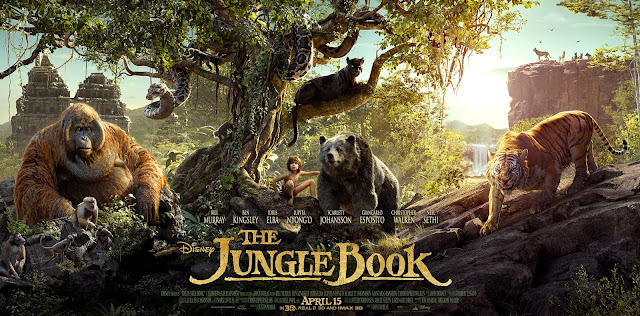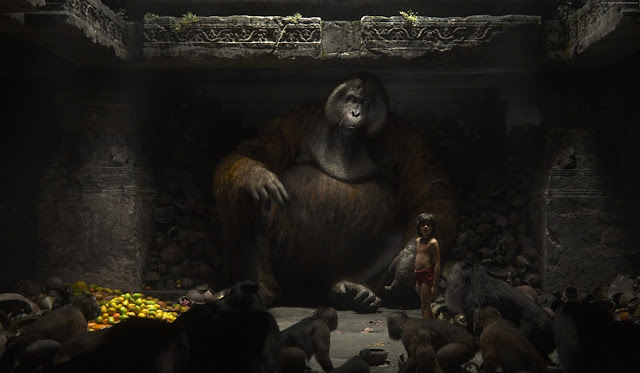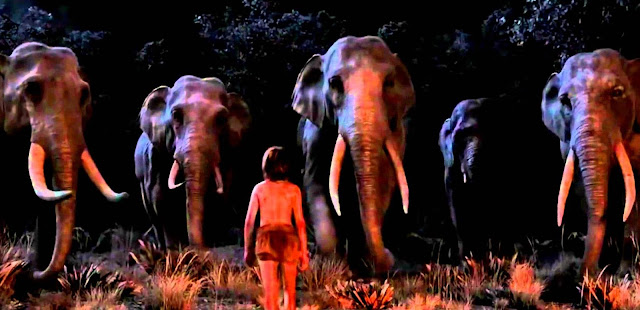By Anirban Lahiri
 |
| The Jungle Book (2016) - By Jon Favreau |
Multiple films, and TV series, have been made on Kipling's mock-fable The Jungle Book (1894), that justified British rule over India through a well-crafted, erstwhile contemporary, folklore. Being the son of both soils, Kipling infused popular eastern tropes well with the orientalist's wisdom. The current offering traces the wolf-bred boy's path among forest folks - bisons, buffalos, monkeys, and the lame tiger, Shere Khan. It is the journey of man taming fire, taming the jungle and how he would be king, retold for the umpteenth time.
Our Rating: 6.5
IMDb Ratings: 7.9
Genre: Adventure|Drama|Family
Cast: Neel Sethi, Bill Murray, Bill Kingsley
Country: USA
Language: English
Runtime: 106 min
Color: Color
Every generation of moviegoers get their own Jungle Book, The Bible, The Norse Myths, Snow White and the basic tales. That is normal as societies refurbish old myths in new garbs to satisfy the social coherence factor - gossip. We evolved from smart ape ancestors to tool using animals with articulate language and a penchant for staying in big collectives, because we have stories. No other species ever believed in such imagined phenomena. Our gods, superheroes, tragic figures, and indeed the whole cornucopia of talking animals, totems and taboos have set us apart from the other animals. Our societies exist on the basis of collectively believed imaginations. Our political systems, economic relations, trade, family life, and the notion of family itself are built on stories, which we take to be true.
Such stories must be retold for every generation to keep societies validated, to refer to the values that our parents instilled in us during the growing years. The simplest form of such stories are the most effective. They are called fables. Extremely powerful writers confabulate such simple tales, through ages, with incomparable ease. In the old days, they were called Rishis, irrespective of their ulterior motive. In the modern days of Raj, Rudyard Kipling penned many such tales, from which The Jungle Book (1894) stands out for its unparalleled simplicity.
The latest version in 3D, which roars over the box office now, has repackaged the fable as per the perceived need for contemporary kids. Fresh, intended, politics seeps through such changes. The original tale was a masterpiece of imagination, shared providence and Kipling's own metaphorical contribution to the British rule over India, his land of birth. The producer, screenwriter and the Director of this film, kept the metaphorical structure alive, but let the purpose astray to find new destination.
 |
| Mowgli, Bagheera and Ballu |
So, Ka, the powerful male rock python, the saviour and mentor of Mowgli, becomes a she-monster echoing the Biblical Serpent and the Satan in one Devilish, Eve-ish body, in the new film. Baloo, the Sloth Bear, turns up late in the film for a friendly pact for food-gathering, and Akela, the leader of the wolf pack - the protector of Mowgli - is killed by none other than Shere Khan.
Such changes must have been made to cut the tale short, and for the intended post-postcolonial audience consisting of school-going kids. The new metaphor is just enough adrenaline pushing for the VR generation in need of control and maze, but no destination. This is a flat, postmodern, Jungle Book, I enjoyed it while sitting in the auditorium, 3D glasses on. But, there was nothing much to bring outside once the film was over.
One deviation from the original must be mentioned here. The image of Bandarlog, almost an echo of Banarji - the Bengali Banerjee, was intentional in Kipling's dish. While Sher Khan was some remnant of the tyrant Afghan-Punjab, and Mowgli a long-lost Tarzan cast almost in the image of Kipling himself, the mock-British Bengali was also to be represented, in the colonial image. In the overarching glory of the past, in which they bask.
The Chief of the Bandarlog, a gigantic Orang Utan (or was he the legendary Gigantopithecus?), reminded me of Colonel Kurtz, from Apocalypse Now (1979), in a mock-serious manner. They resemble in their posture, larger-than-life projection, and spirit. And they do not die. In the end of the film, the leader of the Orang Utan is seen coming out of the rabbles of ages, to mark his imitative way on a new spoil - his imitation of the Philosopher.
And exactly here the new Jungle Book resembles Kipling's original plan, dished out for his sick daughter - a fable made by a sympathetic Englishman on the white man's burden.
To this end, the film acts almost like a moral play - To each his own standing, Mowgli, Kipling's Tarzan (the white skin), finishing on the top of the pyramid, unquestionably.
Readers, please feel free to share your views/opinions in the comment box below. As always your insightful comments are highly appreciated!
References:
The Jungle Book (2016) Trailer (YouTube)
People who liked this also liked...







0 comments:
Post a Comment
Thanks for sharing for valuable opinion. We would be delighted to have you back.